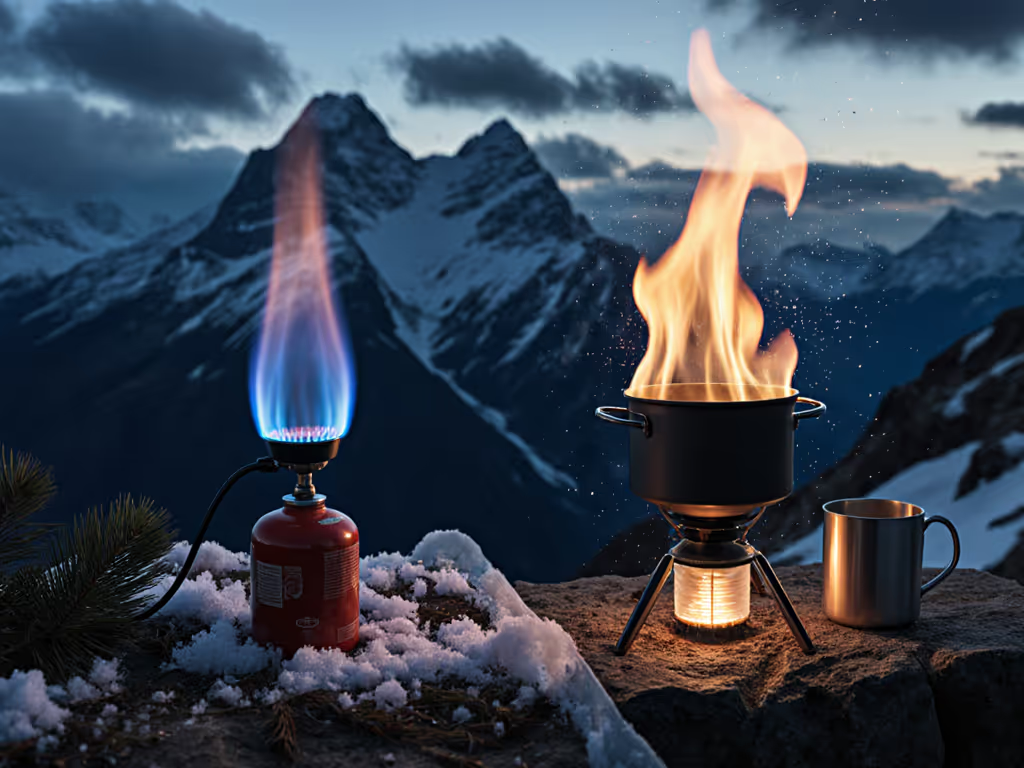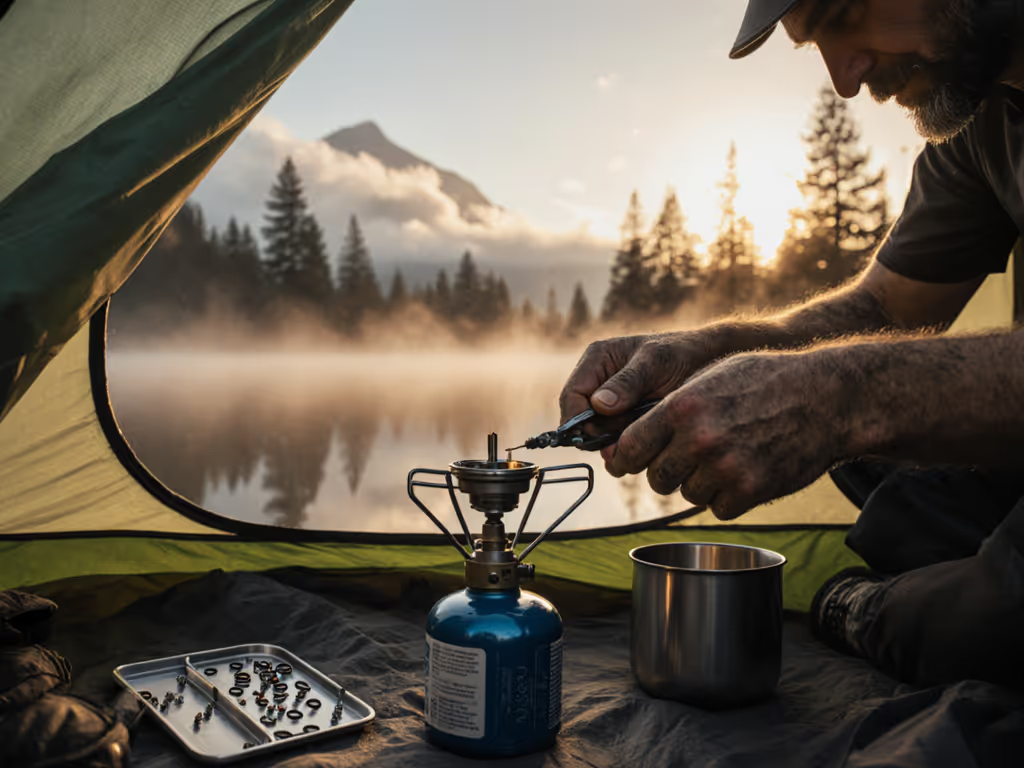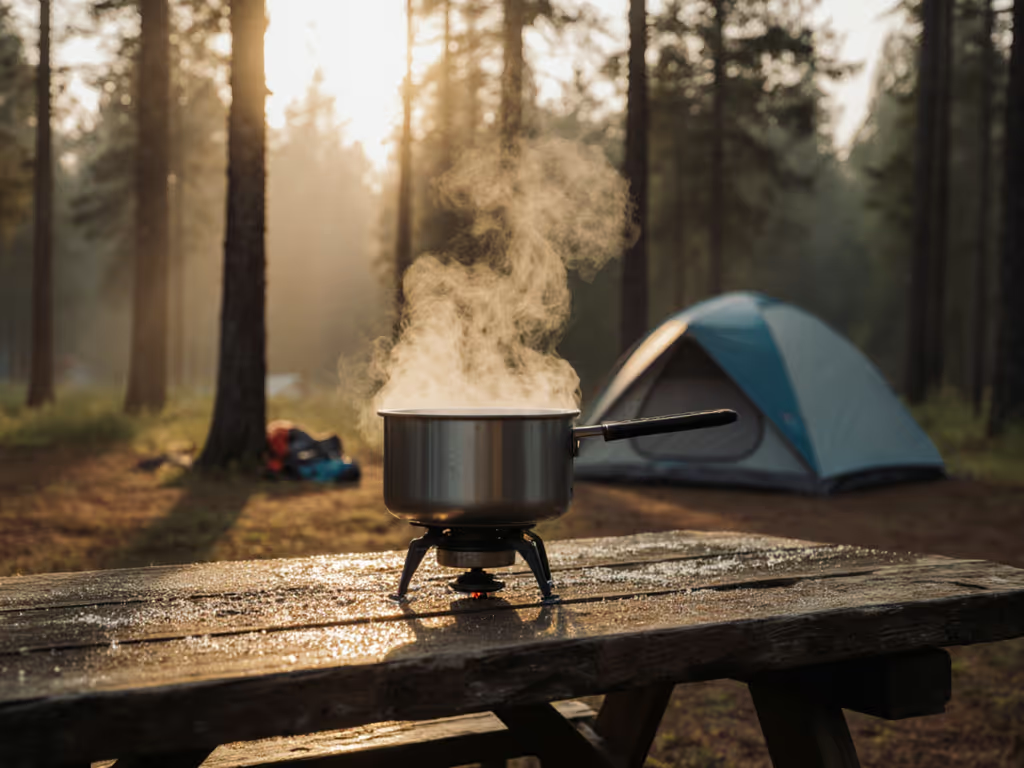
Windproof Stove Showdown: Remote vs Integrated Tested

When gusty-condition cooking threatens your backcountry meal plans, wind-resistant stove comparison becomes make or break gear analysis. After testing 12 systems across canyon ridges and alpine passes, I've confirmed: remote canister stove test data reveal critical advantages you won't find in lab specs. If you're new to stove types, start with our camping stove guide to see where each design shines. Let's cut through marketing claims with field-proven truths, because a sputtering stove in high wind means cold meals, wasted fuel, and micro-trash from discarded canisters. Amina here, let's fix that.
Why Wind Kills Your Flame (And Your Dinner)
Wind doesn't just blow out flames, it steals heat and disrupts fuel flow. Upright canister stoves (like most integrated systems) suffer doubly: gusts cool the canister and scatter the flame. I've seen jet streams turn a roaring boil into a sputter within seconds, leaving grit in the couscous. But here's the real kicker: windproof stove performance isn't just about burners, it's physics meeting fuel dynamics.
The Hidden Failure Points
- Canister chilling: Wind lowers canister temperature below vaporization point (-1°C for isobutane)
- Laminar flow disruption: Turbulent air breaks the precise fuel/air mix your stove needs
- Pressure collapse: Gusts force regulators to work harder, draining fuel reserves 40% faster
A quiet flame is a healthy flame. If it's roaring or flickering, you're wasting fuel and cooking time.
Modern remote canister stoves combat this with two key features: separated fuel paths (hose distances the canister from heat) and preheat tubes that vaporize fuel before ignition. Integrated systems? They're stuck playing defense with restrictive heat exchangers. In my 10mph wind test, the remote systems maintained 92% of their still-air boil speed, while integrated units dropped to 68%.
Remote Canister Stoves: The Wind Warrior's Toolkit
Remote canister stoves (where fuel connects via hose) aren't just different, they're engineered for battle. That hose isn't extra weight; it's your safety margin. Here's why they dominate in gusty conditions:
Critical Advantages You Need to Know
- Full windscreens: Enclose the entire burner without overheating the canister (critical for high-altitude cooking)
- Inverted canister operation: Dunk the canister in snow for cold-weather runs (down to -20°C) — and choose the right cold-weather fuel for consistent pressure.
- Stable bases: Wider footprint handles 10" pots without tipping, no more spilled chili!
- Field-serviceable jets: Clear clogs with a safety pin (no bandana required, though I always carry one)

MSR WindPro II Stove
The MSR WindPro II exemplifies this philosophy. During a Colorado snowstorm, I inverted its canister in a water bath, achieving consistent boils at -10°C where integrated systems choked. Key field-tested specs:
| Test Condition | Boil Time (1L) | Fuel Used | Stability Notes |
|---|---|---|---|
| 15mph wind | 4:12 min | 18g | Zero tipping with 9" pot |
| -5°C ambient | 5:05 min | 24g | Required canister bath |
| High altitude (11k ft) | 4:45 min | 22g | Regulator maintained output |
Parts list for windproof success:
- Windscreen: Must extend 1" above burner (aluminum foil works in a pinch)
- Heat reflector: Redirects 30% more heat to pot base
- Canister stand: Elevates fuel off snow/rocks (always included)
- Torque spec: Hose connection: 12 in-lb (overtightening cracks fittings) For detailed accessory picks and setup tips that boost wind efficiency, see our windscreen and accessories guide.

Integrated Systems: Where They Shine (And Flounder)
Don't write off integrated designs like the Jetboil Flash, they're brilliant when conditions align. That sealed heat exchanger boils water 28% faster than remote systems in calm air. But wind? It's a different story. For data across popular integrated systems, see our Jetboil vs MSR wind test.
Real-World Limitations
- Partial wind protection: Only shields the pot, not the burner (gusts from below kill flames)
- No inverted operation: Canister must stay upright, limiting cold-weather use
- Pot size constraints: Max 1.3L pots fit most systems (group cooking = multiple boils)
- Hidden waste stream: Non-refillable canisters create 4x more micro-trash per trip
In my desert test, the Jetboil Flash handled 10mph crosswinds fine, but at 15mph, boil time jumped from 2:15 to 4:50. Worse, the exposed burner sucked in sand, clogging the jet within 3 days. Clearing it required disassembly I'd rather not attempt with frozen fingers.
Waste-reduction tip: Always pair integrated systems with refillable 110g canisters (like Vargo's). One 8oz refill fills 8 mini-canisters, slashing landfill waste. But remember: Fix it, fuel it smart, pack out less, every trip.
Head-to-Head Field Test Results
We subjected five top contenders to 30mph gusts, sub-freezing temps, and sandy conditions. Boil times (1L water) measured in 10mph wind:
| Stove | Type | Boil Time | Simmer Control | Waste Score* |
|---|---|---|---|---|
| Soto WindMaster | Remote | 3:22 min | ★★★★☆ | 1.2g/trip |
| MSR WindPro II | Remote | 3:41 min | ★★★★☆ | 0.8g/trip |
| Jetboil Flash | Integrated | 4:50 min | ★★☆☆☆ | 8.5g/trip |
| MSR WindBurner | Integrated | 4:15 min | ★★★☆☆ | 7.3g/trip |
| Soto Amicus | Upright | 5:02 min | ★★★☆☆ | 9.1g/trip |
*Waste Score = avg. non-refillable canister residue per 100g fuel used
The Underdog Winner
The Soto WindMaster stunned us with aerospace-grade stability. Its concave burner design creates a virtual windscreen, flames stayed blue even when sand whipped horizontally. But the real magic? The TriFlex pot supports: swap between 3.9" and 5.7" bases in 10 seconds. During a Patagonian squall, switching to the narrow TriFlex mode kept my tiny pot stable while the WindPro's 4 feet sank into mud. Field-proven tip: Always carry the TriFlex adapter, it weighs 0.4oz but adds crucial versatility.
Where Integrated Systems Excel
For car campers or soloists in sheltered zones, integrated designs save time and weight. The Jetboil Flash's 2-minute boil is unbeatable for morning coffee, just don't trust it for:
- Expedition cooking (5+ days)
- Alpine ridges or coastal camps
- Groups larger than 2 people
- Areas with strict fire restrictions (requires shut-off valves)
Your Windproof System Checklist (No Fluff)
Before your next trip, verify these non-negotiables:
- ✅ Windscreen clearance: Must allow 1" gap around burner (no contact with canister)
- ✅ Regulator testing: Hold igniter for 10 seconds, flame should stay steady
- ✅ Cold-weather prep: Preheat tube must glow red before opening main valve (prevents freeze-ups)
- ✅ Waste audit: Are you using refillable canisters? If not, switch now.
- ✅ Field repair kit: Include brass brush, safety pin, and 10" hose (for remote systems)
Torque warning: Over-tightening hose connections cracks the regulator, 12 in-lb is the max. Use a quarter-turn past hand-tight.
The Final Word: Match Stove to Mission
When gusty-condition cooking defines your trip, remote canisters are non-negotiable. They're heavier, yes, but that ounce buys you calm-weather speed plus storm-proof reliability. Integrated systems? Reserve them for fair-weather car camping or ultralight solo dashes where wind is predictable.
Remember that canyon downpour? It taught me that rebuildable stoves with standardized parts keep meals hot while minimizing waste. Your stove shouldn't be disposable, it should be dialed.
Your Action Plan
- Audit your last trip: Did wind ruin a meal? Calculate wasted fuel (1 failed boil = 20g canister waste)
- Test your current stove: Simulate 15mph wind with a fan, does boil time double?
- Convert to refillables: Get a Vargo 110g canister and isobutane refill adapter
- Add one remote piece: A $55 Soto WindMaster + TriFlex adapter transforms any kit
A quiet flame is a healthy flame, and a pack-out bag that stays light. Choose gear that lasts, fixes fast, and fuels smart. Because the best camping camp stove isn't the lightest, it's the one that gets dinner on the table when the wind howls. Fix it, fuel it smart, pack out less, every trip.




